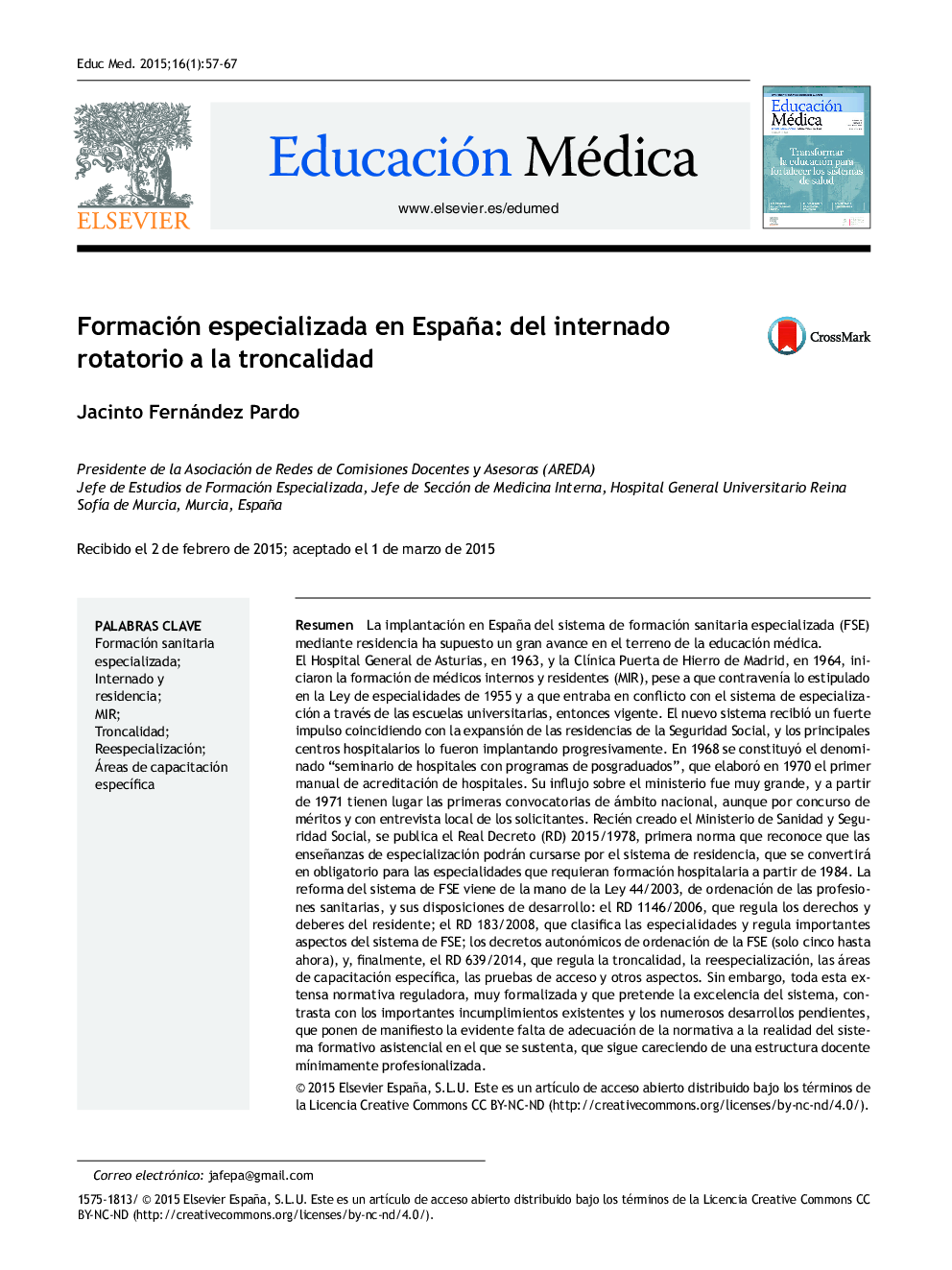| کد مقاله | کد نشریه | سال انتشار | مقاله انگلیسی | نسخه تمام متن |
|---|---|---|---|---|
| 3323806 | 1211940 | 2015 | 11 صفحه PDF | دانلود رایگان |

ResumenLa implantación en España del sistema de formación sanitaria especializada (FSE) mediante residencia ha supuesto un gran avance en el terreno de la educación médica.El Hospital General de Asturias, en 1963, y la Clínica Puerta de Hierro de Madrid, en 1964, iniciaron la formación de médicos internos y residentes (MIR), pese a que contravenía lo estipulado en la Ley de especialidades de 1955 y a que entraba en conflicto con el sistema de especialización a través de las escuelas universitarias, entonces vigente. El nuevo sistema recibió un fuerte impulso coincidiendo con la expansión de las residencias de la Seguridad Social, y los principales centros hospitalarios lo fueron implantando progresivamente. En 1968 se constituyó el denominado “seminario de hospitales con programas de posgraduados”, que elaboró en 1970 el primer manual de acreditación de hospitales. Su influjo sobre el ministerio fue muy grande, y a partir de 1971 tienen lugar las primeras convocatorias de ámbito nacional, aunque por concurso de méritos y con entrevista local de los solicitantes. Recién creado el Ministerio de Sanidad y Seguridad Social, se publica el Real Decreto (RD) 2015/1978, primera norma que reconoce que las enseñanzas de especialización podrán cursarse por el sistema de residencia, que se convertirá en obligatorio para las especialidades que requieran formación hospitalaria a partir de 1984. La reforma del sistema de FSE viene de la mano de la Ley 44/2003, de ordenación de las profesiones sanitarias, y sus disposiciones de desarrollo: el RD 1146/2006, que regula los derechos y deberes del residente; el RD 183/2008, que clasifica las especialidades y regula importantes aspectos del sistema de FSE; los decretos autonómicos de ordenación de la FSE (solo cinco hasta ahora), y, finalmente, el RD 639/2014, que regula la troncalidad, la reespecialización, las áreas de capacitación específica, las pruebas de acceso y otros aspectos. Sin embargo, toda esta extensa normativa reguladora, muy formalizada y que pretende la excelencia del sistema, contrasta con los importantes incumplimientos existentes y los numerosos desarrollos pendientes, que ponen de manifiesto la evidente falta de adecuación de la normativa a la realidad del sistema formativo asistencial en el que se sustenta, que sigue careciendo de una estructura docente mínimamente profesionalizada.
The implementation in Spain of the system of Specialized Healthcare Training (SHT) through residency has been a breakthrough in the field of medical education. The Hospital General of Asturias, in 1963, and the Clínica Puerta de Hierro of Madrid, in 1964, initiated the education of intern and resident physicians, despite that it contravened provisions of the law of specialties of 1955 and was in conflict with specialization through the system of university professional schools, then existing. Coinciding with the expansion of the residences of the Social Security, the new system received a strong boost and the major hospital centres were progressively implementing it. In 1968, the so-called “seminario de hospitales con programas de posgraduados” was founded, and in 1970 drew up the first accreditation manual for hospitals. Their influence on the Ministry had a large impact, and in 1971 the first nationwide call took place, although by merit-based selection and with local interviews to applicants. Newly created the Ministry of Health and Social Security, is published Royal Decree (RD) 2015/1978, the first regulation that recognizes that the teachings of specialization may be performed by the residency system, that will become mandatory for specialties that require hospital training from 1984. Reform of the system of SHT comes with the Law 44/2003, of organization of the health professions, and its development provisions: RD 1146/2006, regulating the rights and duties of the residents; RD 183/2008, which classifies the specialties and regulates important issues of the system of SHT; regional decrees of organization of the SHT (only five currently); and finally RD 639/2014, that regulates the common core curricula of the specialties (troncalidad), the re-specialisation, the areas of specific training, the tests for the entrance and other aspects of specialized training. However, all this extensive regulation, very formalized and that aspires to excellency, contrasts with the lack of compliance of some important mandates and with several pending developments, which demonstrate the regulation's evident lack of adaptation to the reality of health care system on which it's based, that continues to lack a minimal professional teaching structure.
Journal: Educación Médica - Volume 16, Issue 1, January–March 2015, Pages 57–67